 |
 |
 |
| |
Virological Response and Resistance in Multi-Experienced Patients Treated with Raltegravir
|
| |
| |
Reported by Jules Levin
XVII HIV Drug Resistance Workshop
June 10-14, 2008
Sitges, Spain
F Ceccherini-Silberstein1,2, D Armenia1, R D'Arrigo2, V Micheli3, L Fabeni1, P Meraviglia3 , A Capetti3, M Zaccarelli2, MP Trotta2, P Narciso2, A Antinori2, CF Perno1,2
1University of Rome Tor Vergata, Rome, Italy; 2INMI "L. Spallanzani", Rome, Italy; 5Hospital Sacco, Milan, Italy.
AUTHOR CONCLUSIONS
RALtegravir showed an extraordinary potent antiretroviral and immunological efficacy in the large majority of multi-experienced patients.
In a minority of patients, a rapid resistance to RAL emerged and correlated with later virological outcome, thus confirming the importance of associating this new integrase-inhibitor to other active drugs to maintain long-term efficacy.
The pattern of mutations found in patients failing the RAL-containing regimen is heterogeneous involving mutations at positions such as E92, T97, S119, E138, G140+Q148, Y143, K156, N155, G163, V165I, D232.
All these mutations were absent at baseline, with the exception of T97A and G163R rarely present (<2%), or K156N and V165I present as natural polymorphisms (>14%).
Patients presenting at baseline or T97A, or G163R, or V165I mutation showed a trend of rapid accumulation of other resistance mutations under RAL-therapy (Y143R, T97A, or N155H, respectively), suggesting that different patterns of mutations conferring resistance to RAL can be related to selected polymorphisms present at baseline.
BACKGROUND
Human immunodeficiency virus (HIV) encodes three enzymes essential for viral replication: reverse transcriptase (RT), protease (PR) and integrase (IN). Currently, the majority of approved antiretroviral drugs (NRTIs, NNRTIs, and PIs)
inhibit the enzymatic activity of RT and PR. Raltegravir (RAL) is a novel and potent integrase-inhibitor, recently FDA approved, that showed very promising results in clinical-trials. However, data about the efficacy of RAL in uncontrolled studies, as well as dynamics of resistance mutations, are yet to be defined. It is known that the high level of genetic diversity, characteristic of HIV-1, has important implications for evolution of resistance. It is possible that pre-existing IN resistance-associated mutations could reduce the "genetic barrier" to resistance and accelerate treatment failure.
AIM
·To characterize the prevalence of IN mutations in HIV-1 infected patients at baseline and during the treatment of RAL.
·To analyze the role of natural polymorphisms in the evolution of resistance.
·To analyze the potential correlations between the virological response and the development of short-term resistance.
METHODS
51 HIV-1 infected treatment-experienced patients with triple-class resistant virus who received RAL plus optimized-background-therapy (OBT) were analyzed. Integrase genotyping together with CD4 and plasma HIV-1-RNA were assessed at baseline and at weeks 4-24.
The IN genotype analysis was performed on plasma samples by using home made genotype method, by means of commercially available RNA-extraction, reverse transcription (RT)-PCR amplification and genotyping kit. For the IN sequencing 4 different overlapping sequence-specific primers have been used for an automated sequencer (ABI-3100) and using SeqScape-v.2.0 software.
To assess the association of integrase mutations with treatment or failure Chi squared test or Fisher test were performed. The durability of antiretroviral and immunological activity was assessed by the following endpoints measured at weeks 4-24: HIV RNA < 50 copies/mL, HIV RNA < 400 copies/mL, change from baseline in plasma HIV RNA (log10 copies/mL) and change from baseline in CD4 cell count (cells/mm3).
RESULTS
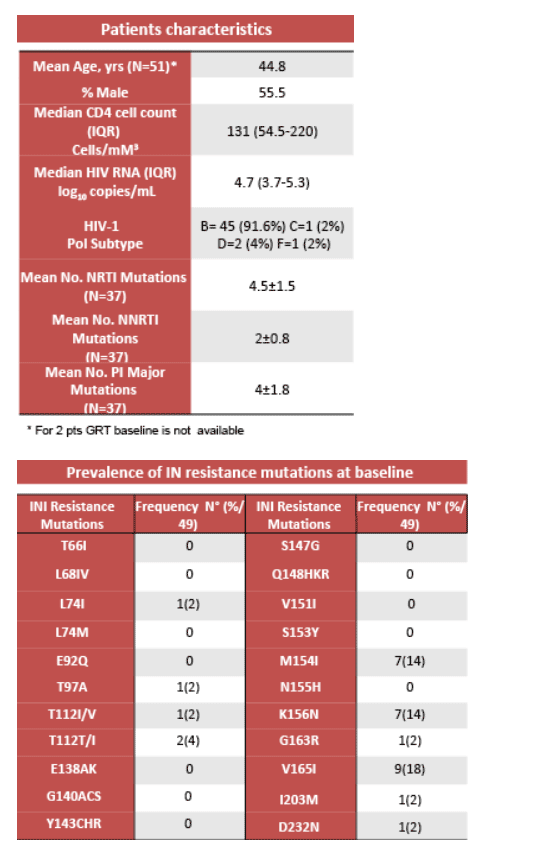
· At baseline, median HIV-1-RNA was 4.7 log10 copies/ml and median CD4 cell count was 131/mm3.
· Baseline sequences showed no primary RAL resistance mutations (E92Q, E138K, G140ACS, Y143HCR, Q148HKR, N155H).
·Some secondary mutations were present with a prevalence <5%, such as L74I, T97A, G163R, I203M, D232N, while mutations M154I, K156N, V165I were present with a prevalence >14%.


· At 7-19 days after RAL-based therapy, a very sharp decrease of HIV-1-RNA (median reduction -2.2 log10 copies/ml) was found.
· After 4 weeks, the HIV-1-RNA change was -2.43 log10 copies/ml, and 45% of patients reached <50 copies/ ml. CD4 cell-count change was 76 cells/mm3 (p=0.007).
·At week 24, <50 HIV-1-RNA copies/ml was achieved in 67% of available patients and maintained to the end of observation period.
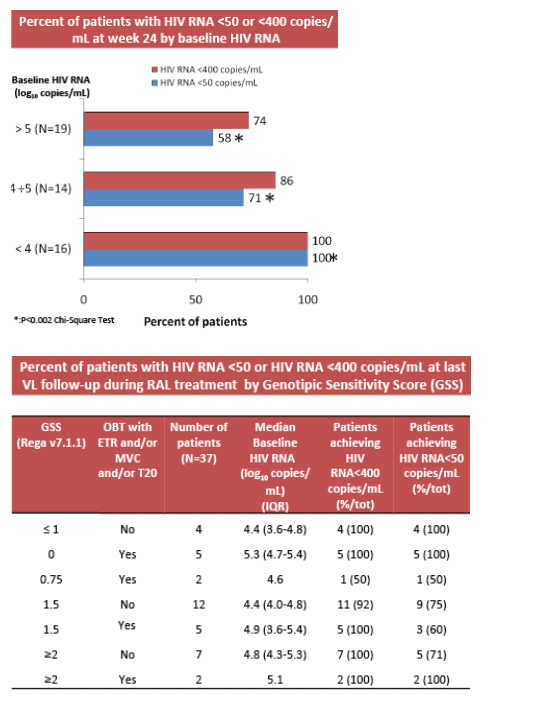
· For 37 patients was evaluated the OBT-GSS, based on PR and RT sequences available at baseline before RAL treatment.
· The majority of patients (76%) showed a GSS <1.5; of them, 93% achieved HIV-RNA <400 copies/mL and 86% achieved HIV-RNA <50 copies/mL.
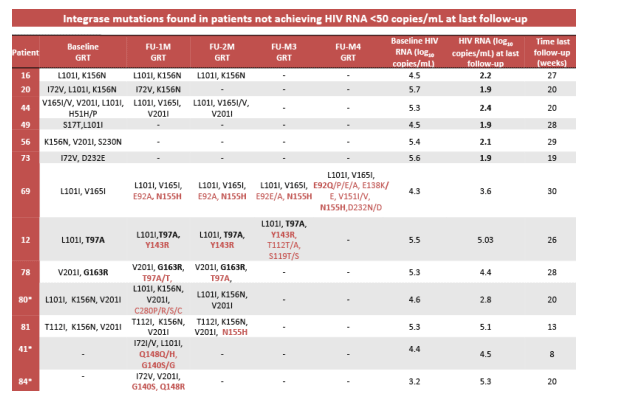
* Patient 80 was with 12 days in treatment interruption; for patients 41 and 84, GRT at baseline were not available.
Six patients achieving HIV-RNA < 400 copies/ml are shown in bold.
· The development/selection of IN resistance mutations in RAL-failing patients was very rapid, between the 1-2 month of RAL therapy.
The pattern of mutations found in patients failing the RAL-containing regimen was heterogeneous, involving IN mutations N155H (2 pts), Q148H/R+G140S (2 pts), Y143R+T97A (1 pt), G163R+T97A (1 pt). Five patients not reaching HIV-RNA <50 copies/mL (2 with HIV-RNA >400 copies/mL) showed the mutation K156N at baseline and at failure. Patients showing at baseline the mutation T97A or G163R, did not reached <50 copies/mL, and failed accumulating other resistance mutations (Y143R, T97A, respectively).
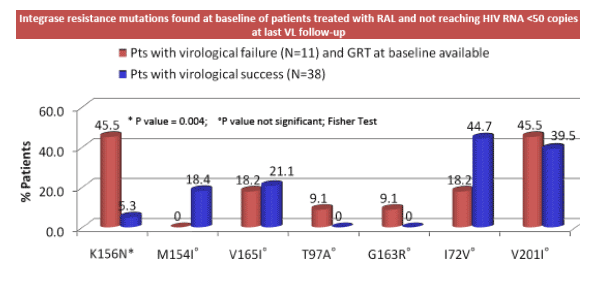
· The presence of novel mutation K156N at baseline was significantly associated with HIV-RNA >50 copies/ml during RAL treatment. An opposite trend was observed with the presence at baseline of mutation M154I (100% of patients with the mutation reached <50 copies/mL). Interestingly, both residues are adjacent to the N155H.

· The presence of N155H mutation was significantly associated with RAL treatment. However its presence was not significantly associated with a concomitant virological failure to the RAL-containing regimen. Two out of 4 patients that showed N155H during RAL treatment reached before 24 weeks HIV-RNA <50 copies/mL:
- One patient (with HIV-RNA at baseline >5.6 log10 copies/ml) treated with DRV/r+FTC+RAL+TDF showed after 4 weeks the N155N/H mutation and reached HIV-RNA <50 copies/mL at 12 weeks.
-The other patient is shown below.
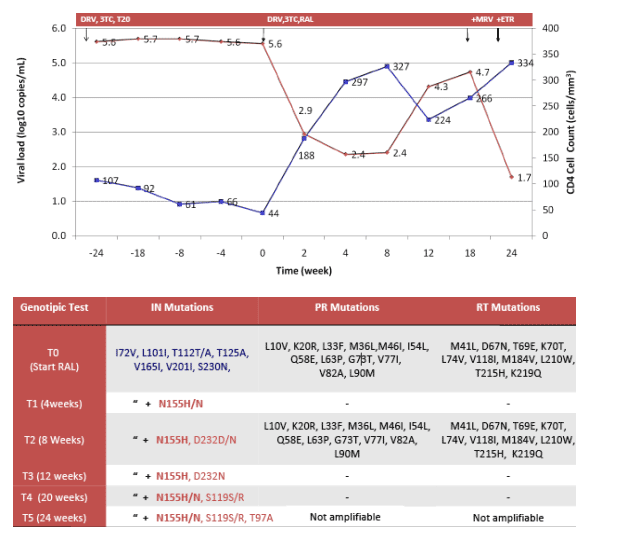
Three out of 4 patients presenting the N155H mutation had at baseline the V165I secondary mutation, suggesting that different patterns of mutations conferring resistance to RAL can be related to selected polymorphisms present at baseline.
|
| |
|
 |
 |
|
|